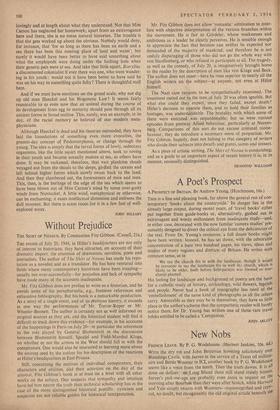Down to the Sea Again
THE EDGE OF THE SEA. By Rachel Carson. (Staples, 18s.) MISS CARSON has .dived more deeply into more books about the sea than most professional oceanographers with a set of ideas of their own. The last time she came to the top triumphant with a hest-seller as tangy and toothsome as a fresh-boiled shrimp. Whole libraries of lore, most of it undredged before, must have gone into her popular compendium of the deeps. But somehow she seems less sure in shallow water. This may be because, unlike the edge of the sea, almost nothing is known about the abyssal floor of the ocean. The imagination can rove around the thought of a vast vat of brine, six miles deep, not far off the Philippines. But VI the twitchy, little tenants of rock pools and tide flats have been flushed out and pushed under the microscope. We know too much about them, particularly here in Britain where Ellis, Pennant, Gorse (Father not Son), Forbes and, latterly, Yonge have written lovingly and at length about what they understand. Not that Miss Carson has neglected her homework; apart from an extravagance here and there, she is no mean natural historian. The trouble is that she gets worked up about the obvious. Nobody would deny, for instance, that 'for as long as there has been an earth and a sea there has been this meeting place of land and water'; but surely it would have been better to have said something about what the amphipods were doing under the bathing huts when their generic pals were at sea. And take that little squirt, Botryllus. a discontented colonialist if ever there was one, who went wander- ing in his youth: would not it have been better to have said he was on his way to something quite fishy? There is thoughtful stuff here.
And if we must have emotions on the grand scale, why not dig up old man Haeckel and his Biogenetic Law? It seems fairly reasonable to us even now that an animal during the course of its development from egg to maturity should pass through all its ancient forms in broad outline. This, surely, was an example, in its day, of the racial memory so beloved of our modern meta- physicians.
Although Haeckel is dead and his theories outmoded, they have laid the foundations of something even more evocative, the present-day concept of Pxdomorphosis, or change through the young. The idea is simply that the larval forms of lowly, sedentary organisms, like the little squirt mentioned above, took to roving in their youth and became sexually mature-at sea, as others have done. It may be reckoned, therefore, that vast plankton shoals voyaged out from the shoals to the deeps, girdled the oceans and left behind higher forms which slowly swam back to the land. And then they clambered out, the forerunners of mice and men. This, then, is the heritage of the edge of the sea which seems to have been blown out of Miss Carson's mind by some over-gusty winds from Nantucket. A little wind, metaphysical or otherwise, can be enchanting; it eases intellectual distension and enlivens the dull moment. But there is scant room for it in a few feet of well- explored water.
JOHN HILLABY



































 Previous page
Previous page